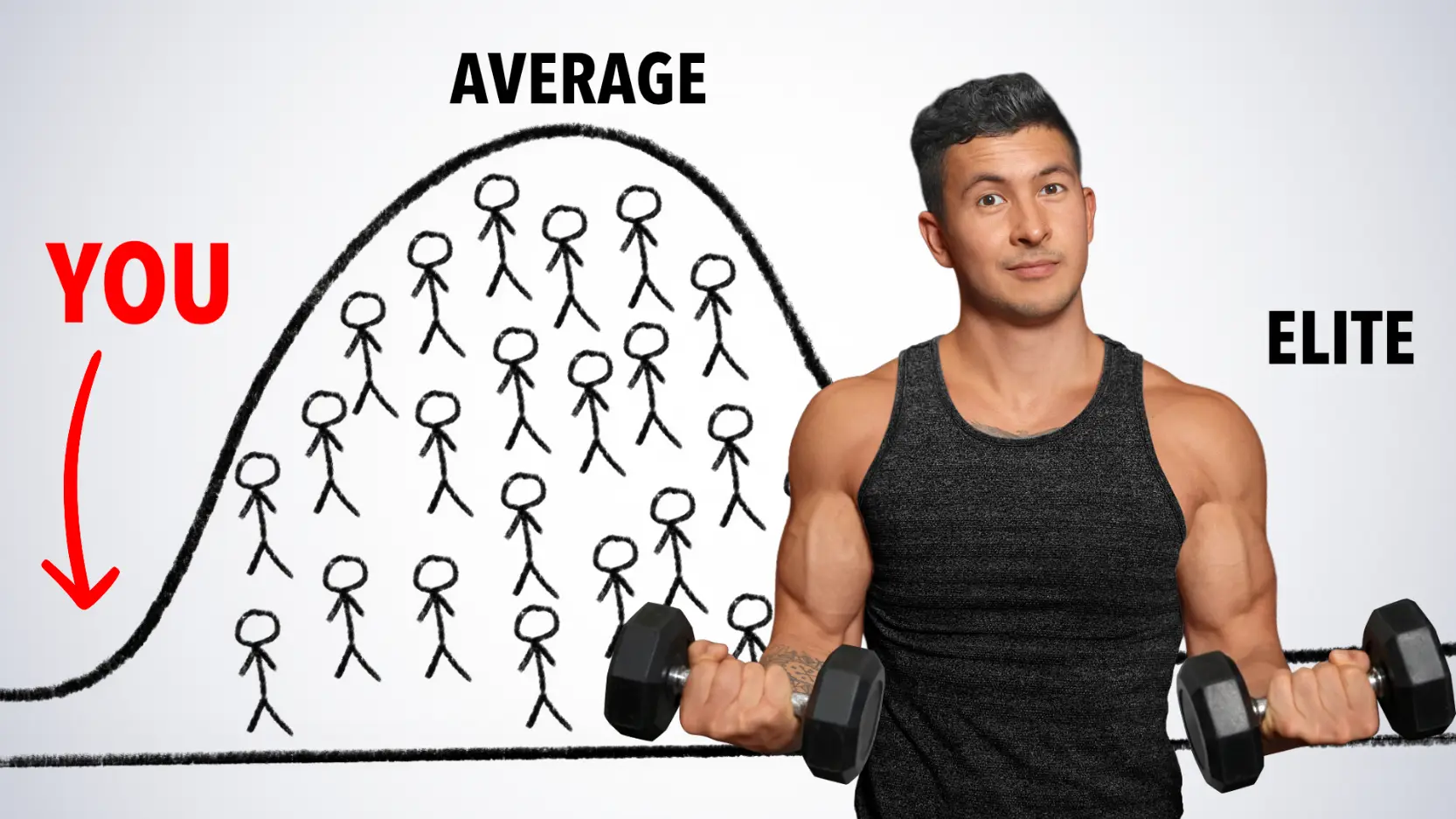
How to BEAT Your Crappy Muscle Genetics (Using Science)
Ever wonder why some guys blow up in months while others barely change after years of training? The answer lies in your muscle genetics and how you play the hand you’re dealt.

What if I told you this guy eats less than 1,500 calories a day, yet his muscle growth speed is unheard of? At 15, BEFORE he even touched a weight, his arms were bigger than most grown men.
Meanwhile, this was me.

Narrow shoulders, skinny frame — I looked like a stick you’d find in your backyard.
So, I dug into science to find a way to beat my crappy muscle genetics, and I finally transformed from this to this.
How?
Ways Muscle Genetics Affect Your Gains
There are 3 main ways muscle genetics affect your muscles: How fast they grow. Which ones grow the fastest. And your natural limit.
Let’s start with speed, where I’ve got two perfect examples. My friend Max ...

... and Ryan, a record-breaking lifter.

We even did a bench press article together not long ago.
Max:
"After probably 7 or 8 months of lifting, I was able to get up to 225 lbs on my bench press… definitely faster than my peers.”
Ryan
“For me, it’s kinda sad that people don’t believe it’s possible naturally… I want to be the example that it is.”
And then you’ve got the extreme outliers. Take Julian, a 19-year-old who built such a crazy physique in just a few years that Jeff Nippard even did a video questioning whether he was natural.

Jeff Nippard:
“Like, the arms are literally bigger … like Arnold.”
Ryan
"It's certainly possible, people respond better than others to certain things, and that can even be due to the way they train, maybe the way they found a very effective way to train that, maybe he managed to capitalize on that… I do tend to give the benefit of the doubt. Obviously there’s a possibility that he’s lying. If he is, thats very unfortunate."
Regardless of whether Julian is or isn’t natural, the truth is clear: some people are genetically wired to grow muscle faster than the rest of us (i.e., they're blessed with the "good" muscle genetics).
Imagine you took 287 people and had them all do the exact same full-body workout twice a week for 6 months.
Back in 2016, a group of scientists did just that, but used MRIs, Dexa scans, and ultrasound to measure muscle growth as accurately as possible.
The results?
All over the place.
But they quickly noticed three types of muscle genetics:
- Hyperresponders. These people grew 2-3x faster than the average, growing their muscles up to 30% bigger.
- Average responders. This is where most people fell under. Growing their muscles by about 5-10%.
- Low-responders. Who barely built any muscle, with some even losing muscle!
Remember, this was with the exact same training routine.
Imagine you and your gymbro never miss a training session together, and after 6 months, your buddy gets jacked, whereas you've LOST muscle (sad skinny guy flexing flat muscle in a mirror).
What's Behind Our Muscle Genetics?
But what exactly in our muscle genetics is causing this? Maybe it’s possible to do something about it.
One genetic candidate is myostatin, which inhibits muscle growth. But why? Isn’t bigger muscle = healthier?
Well, in our ancestral days, we never knew when our next meal was gonna come. And since carrying tons of muscle around burns a lot of calories, God looked out for us by hooking us up with myostatin, preventing us from getting “too big”.
But what happens when you remove it?
Well, a Belgian breed of cattle is actually born without myostatin, and they get abnormally massive as a result. We see the same in dogs and even mice when you remove myostatin.
But in humans, the first case of a human mutation in the Myostatin gene was first documented in a 2004 study, where a German newborn was pretty much jacked right out of the womb. By the time he was 4 years old, he was able to hold 7-pound dumbbells straight out to his sides.
Paul Durand, a natural bodybuilder, is thought to have this deficiency.

This is what he looked like before even touching a single weight.

Paul:
"I first noticed I was gifted in the muscle genetics area at around age 5 to 6.
So I was in the bush just playing around. I always like to flex my muscles just because, like I could feel everything, and then I was in the bush, just kind of going like this and similar to like this.
Just think of a five-year-old with a bicep. I was like, there's something to this.
Starting in elementary school, I got accusations for being on steroids by, like, all my friends in about grades 2 to 3.
And then by grade like five, that's when it was like, okay, are you on steroids? Like, no, I'm not on steroids.
So someone says like, eat as much protein as you can. But I haven't even gotten my protein goals over the past. Like, let's say 13 years of training.
I can get away with not eating as much as I need or as other people would think I would need.
I'm in a caloric deficit at all times."
However, this mutation is actually extremely rare; in every one million people, 4 might have it. So it doesn’t explain the differences we see in most lifters.
What it does tell us, though, is that muscle genetics can have a huge impact on how much muscle you build and how quickly.
How To Tell If You Have Good Or Bad Muscle Genetics
But before we dive into the 3 strategies to beat your genetics and grow muscle faster, how can you tell if your genetics are good or bad in the first place?
Well, some people think that if you’re born with a wide frame, you have good muscle genetics and a body type that builds muscle faster.
And there is some truth to it.
A recent study investigated this exact question and found that people with wider frames tend to start off with more muscle. But when researchers looked at how quickly they built additional muscle compared to narrow-framed lifters, the advantage was pretty small — barely detectable.
What a wide frame does, though, is create the illusion of broader shoulders.
And if you’re like me and were born with a narrower frame, don’t worry, I’ll show you later how I worked around that.
But a better way to actually assess your muscle genetics is to look at how quickly you gained muscle and strength in your first year of training.
Ryan:
"So I hit 100-pound dumbbells at the end of my first year, but it wasn't with good form."
After just 1 year of training, this is what Max looked like.

And this is what Ryan looked like.

It would take most guys, including myself, at least a few years to achieve that look, let alone lift the amount of weight they were lifting.
So here’s the real question: if you’re a low or average responder like me, are you stuck there forever? Not even close. You can absolutely speed up your progress and get way more out of your muscle genetics than you think.
How To Get More Out Of Your Muscle Genetics
Strategy #1: Increase Volume
The first strategy for getting more out of your muscle genetics is training volume, so how many sets you’re doing in the gym.
Dr. Eric Helms:
“The first time I went to what I would call a high volume approach ... was the offseason of 2011, and I blew up. My upper body finally caught up to my legs, and there were visible improvements, and a lot of people were saying a lot of good things.”
That’s Dr. Eric Helms, a pro natural bodybuilder and one of the most respected researchers in the field.
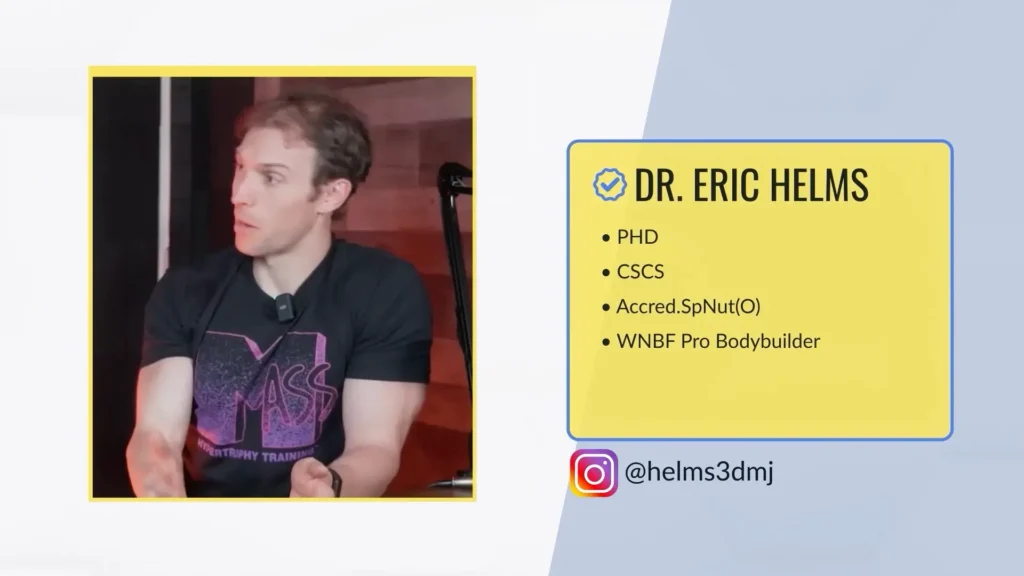
And he told me that every time he’s pushed his training volume higher, he’s seen the fastest gains of his entire career… even after 20 years of lifting.
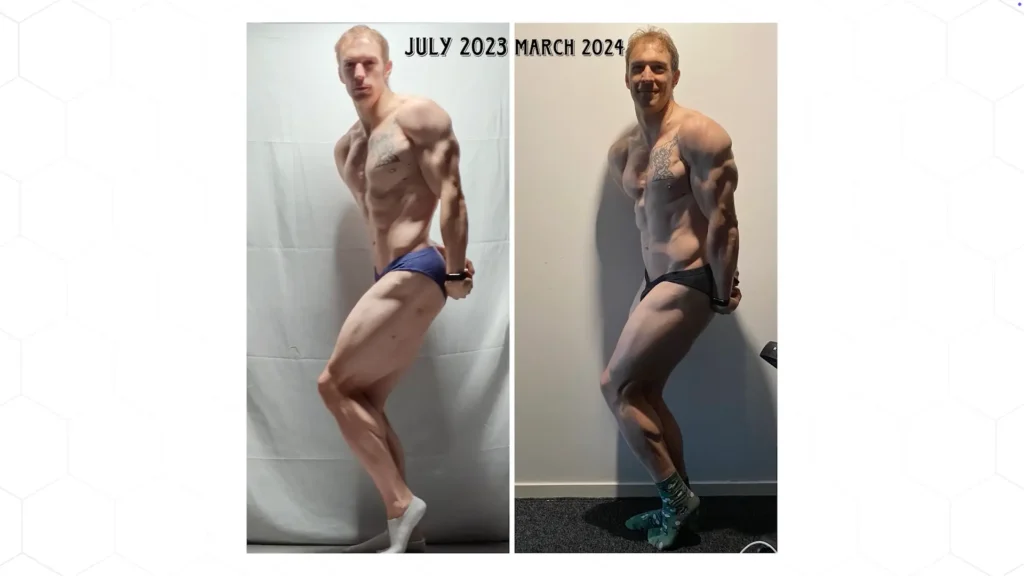
But does ‘more is better’ apply to everyone? Or are there people who actually do better with less?
Well, Eric recently co-authored a one-of-a-kind study that may have finally answered this.
Dr. Eric Helms:
"So one limb did a lower volume protocol, one limb did a higher volume protocol. Then, they had a washout period, during which they returned to their normal training.
They came back and they did it again. This allowed us to determine whether this was simply a statistical fluke.
But everyone seemed to respond better to the higher volume protocol in the first arm and the first and the second arm of the crossover. And it doesn't indicate that there are certain people who are unique high responders to lower volume."
So what does this mean for you? Well, if you’re a low responder, you can potentially match the gains of a higher responder by simply doing more.
But — and this is important ...
How Much More Depends On Where You’re Starting From
If you’re doing under 12 sets per muscle per week, this is where you’ll see the biggest benefit. Bump it up by about 20 to 30%. That could mean adding a couple of extra sets to the exercises you’re already doing, or slotting in an additional exercise for that muscle group.
If you’re in the 12 to 20 set range, the returns are smaller. At this point, you’ll only want to increase if you’re confident your form, effort, and recovery are already dialed in.
And if you’re already cranking out more than 20 sets per muscle per week? The extra push probably isn’t worth the squeeze.
Strategy #2: Specialize That Volume
Luckily, there is a muscle genetics trick that can make you look like you've gained 10 lbs of muscle, even if you've only gained 2: specialization.
If you can only gain so much muscle each year, and only recover from so much volume, the smartest move is to spend that ‘volume budget’ where it makes the biggest visual impact.
For me, that was my shoulders. I was born with narrower clavicles, so I basically had a 1:1 shoulder-to-waist ratio. For context, the ‘ideal’ ratio for aesthetics from a few studies is closer to 1.6, creating the V-taper most guys want and apparently most girls love.
So, one year, I decided to put everything else on maintenance and go all-in on growing my shoulders. After just a year, the scale barely moved, but visually it was a complete transformation, as if my narrow shoulder bones actually grew wider.
Girls can reap the benefits of specialized volume, too!
Bret Contreras, who’s dedicated his career to studying glutes, often has his clients train glutes three times per week, sometimes with up to 30–40 sets per week!

For “personal interest”, I trained my girlfriend, now wife, the same way, and she clearly outgrew the “flat butt” she thought she was genetically cursed with.

How To "Hack" Your Muscle Genetics With Specialized Volume
So, how do you actually apply specialized volume?
First, select the one or two muscle groups you want to target. For guys, that usually means wider shoulders or bigger arms — those are the muscles that make you look the most jacked.
For women, the glutes are the most common focus.
But honestly, it can be whatever you feel is your weak point. From there, start those focus muscles at around 10 sets per week, trained at least twice a week. Then, slowly add about 2 sets per week until you’re up around 20 to 30 sets. The exact number will depend on how much volume you can personally recover from.
But here’s the important part — to save up ‘recovery room’ for your focus muscles, you’ll want to dial back everything else.
Keep your other muscles at about 8 to 12 sets per week.
And for the areas you’re already naturally strong in, you can drop them even lower — just 4 to 6 hard sets per week is usually enough to maintain size.
Run this for a few months, see how your body responds, and then decide if you want to repeat the cycle or shift your focus to a new muscle group.
This used to be difficult for me to keep track of every week, which is why I created our Built With Science Plus app. It automatically adjusts your routine to focus more volume where you need it the most, using the exact principles I just explained.
That way, instead of just guessing and risking burnout, you can follow a plan that’s already optimized for you.
Strategy #3: Set Realistic FFMI // Find Your Max Potential
But if you just crank up the volume and train smarter, does that mean everyone, no matter their muscle genetics, can look like The Rock?
Not quite.
The last piece of your muscle genetics story is your natural limit. And the best way to measure it is with something called the Fat Free Mass Index or FFMI. Think of it as your “jacked score”, the higher it is, the more jacked you are.
Here are some examples:
- My creative director, Dennis, is around 18.
- Tom Holland in Spider-Man? 20.
- Cristiano Ronaldo? 21.
- I’m right around 22.
- Henry Cavill in Superman was 23.
- Stallone in Rocky? 25–26.
- And The Rock or John Cena in their primes? 28 to 30.
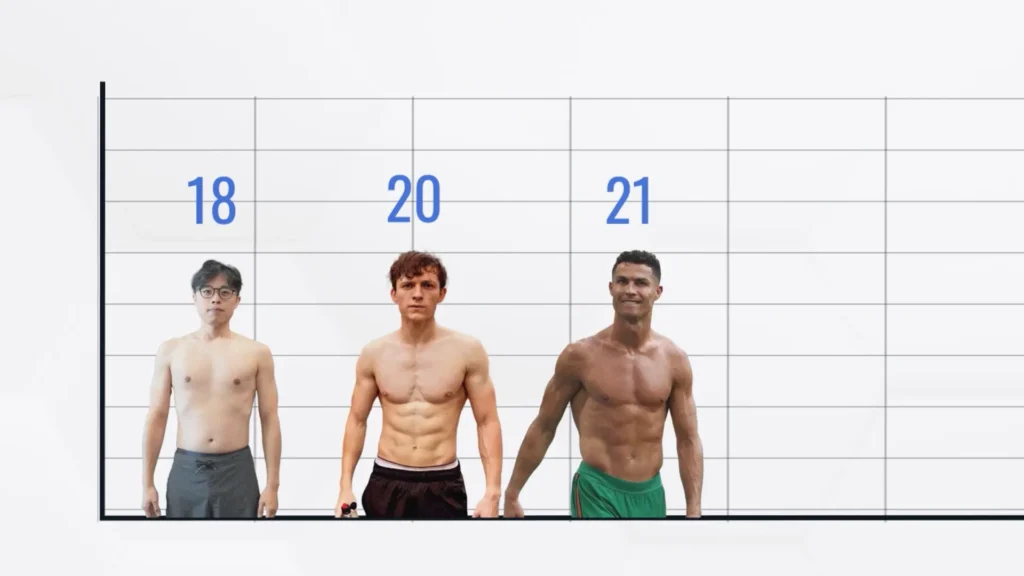
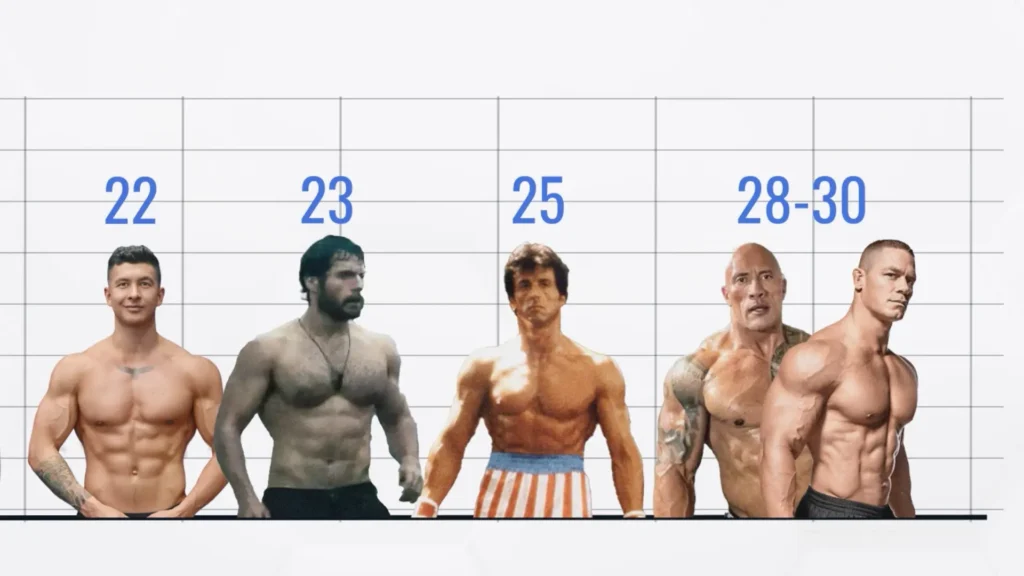
To calculate your score, first, estimate your body fat using these photos. Once you’ve picked one, multiply the number under it by your current bodyweight in kgs.
That’s an estimate of how much fat you’re carrying right now.
Subtract that number from your current bodyweight in kgs to get how much lean mass you have, and then divide that by your height in metres squared.
To calculate your score, look at these photos and pick the body fat that looks most like you.
Multiply the number in that photo by your current bodyweight in kilograms. That tells you how many kilograms of fat you have.
Subtract that fat number from your bodyweight. That gives you how much of your body is lean mass.
Take your lean mass number and divide it by your height in metres squared, or in other words, your height multiplied by itself. The result is your score.
But the bigger question is:
How High Can You Push Your Muscle Genetics Score?
To answer this, I turned to Dr. Eric Trexler.
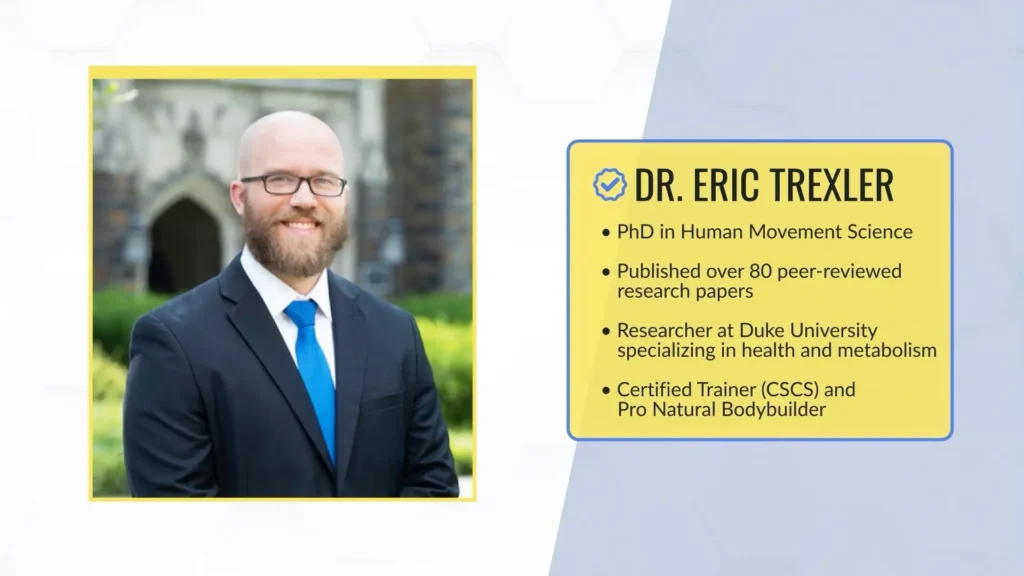
Using decades of data, he’s modeled the most accurate roadmap we have for natural muscle growth potential.
Let’s start with the average person, who, before lifting, usually has a fat-free mass index of 19.
Here you can expect to gain about 8-10 lbs of muscle in your first year of lifting, about 5 lbs in year two, and then less and less each year onwards. Eventually maxing out at a fat-free mass index of 22 to 23.
Now, a low responder?
You gain about half as much. Capping you at an FFMI of 20 to 21. Which is still lean and athletic, and already more muscular than about 70% of the population.
But a high responder with great muscle genetics? Completely different story.
Eric Trexler:
"We know that some people get absolutely jacked when they lift. Other people don't.
Yeah, I've talked to people who train professional football players, who literally have to stop training their upper body because their bicep gets so big they can't hold a football anymore."
These gifted muscle genetics guys can pack on over 20 pounds of muscle in their very first year, and keep gaining steadily for years. In total, more than 40 pounds of muscle over a lifetime.
That’s enough to push their FFMI to 24 or higher — putting them in the top 1% of naturals, right around where my friends Max, Ryan, and Paul are.
And then of course, you’ve got steroid users who go way beyond their muscle genetics.
They’re in a completely different league. Dr. Mike Israetel — who’s open about being enhanced — shared his DEXA scan with me, and I calculated his fat-free mass index score at a whopping 35, breaking the scale.
As for me, I'm around 22, which already makes me more muscular than about 95% of Americans.
At this stage, even putting on 1 or 2 pounds of muscle in an entire year is a win. So if I set a goal of hitting 25? I’d be dead before that ever happens. But to get to 23? I’d have to gain about 8 more lbs of muscle. It’ll take a while, but it’s realistic and gives me a clear, achievable target.
Now, if you also want to see exactly what your target weight would be at your goal muscularity and body fat, Dr. Trexler and I built a calculator that does all the math for you.
Just plug in your stats here and it’ll show you your current ‘jacked score,’ where you rank compared to others, and exactly how much muscle you’d need to hit your goal.
Your Muscle Genetics Isn't The Full Picture
And here’s the encouraging part: being lean makes you look way more jacked.
Take Bruce Lee, or Brad Pitt in Fight Club. Both fall right into the 20 to 21 range, but have the athletic, lean physiques most guys would kill for.
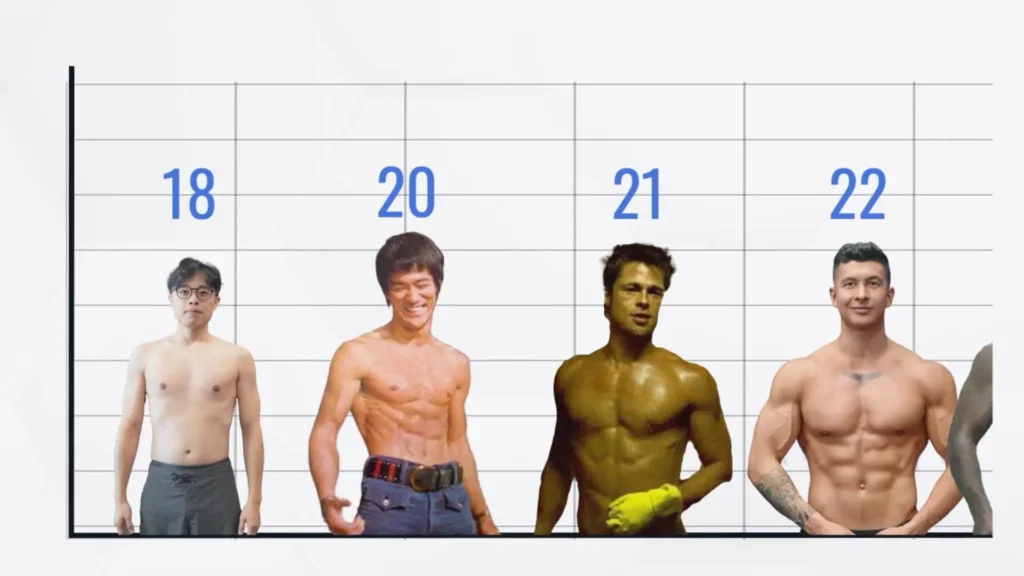
But here’s the problem: most people still never get close to even that level.
And it’s usually not your genetics holding you back. Zac Robinson, a muscle growth researcher, recently showed that a lot of the differences we see in muscle growth studies can’t be explained by genetics alone.
Instead, it’s usually down to things you can control: sleep, nutrition, and training effort.
TL;DR
- 3 ways muscle genetics affect your gains: (1) how fast you grow, (2) which muscles respond fastest, (3) your natural ceiling (often tracked by FFMI).
- Judge the hand you were dealt: forget frame width, your best quick read on muscle genetics is how much size/strength you add in year one.
- Strategy #1 for hacking your muscle genetics: increase volume in a way that fits your starting point: raise weekly sets smartly (biggest jumps if you’re <12 sets/muscle; modest if 12–20; >20 = likely diminishing returns).
- Next, specialize your “volume budget”: direct more work to the muscles that change your silhouette (e.g., delts/glutes) and keep others at maintenance, an efficient way to outshine so-so muscle genetics.
- Finally, know your ceiling, control the rest: set targets with FFMI, then outwork your muscle genetics with dialed-in sleep, nutrition, and effort, the levers that usually explain most progress.
Take Bryan, for example. He had been stuck for years, thinking he was a “low responder”.
But once he joined our Built With Science program, we caught a ton of training and nutrition mistakes he was making.

Turns out, he actually had incredible genetics, but it was his plan holding him back.
And thousands of our app members have experienced the exact same thing, achieving a body they never thought was possible.
So before you blame your genetics, commit to training and eating as if they don’t suck.
And if you want a plan that fast-tracks your results, try our Built With Science+ app free for 2 weeks here:
Click the button below to try the BWS+ app for 2 weeks, for free, no strings attached:
↓
And if you want to see the 2 shoulder exercises that helped me finally beat my muscle genetics and \broaden my own narrow frame, check out this article right here.
Remember: your muscle genetics are just your starting point, not your final destination.




